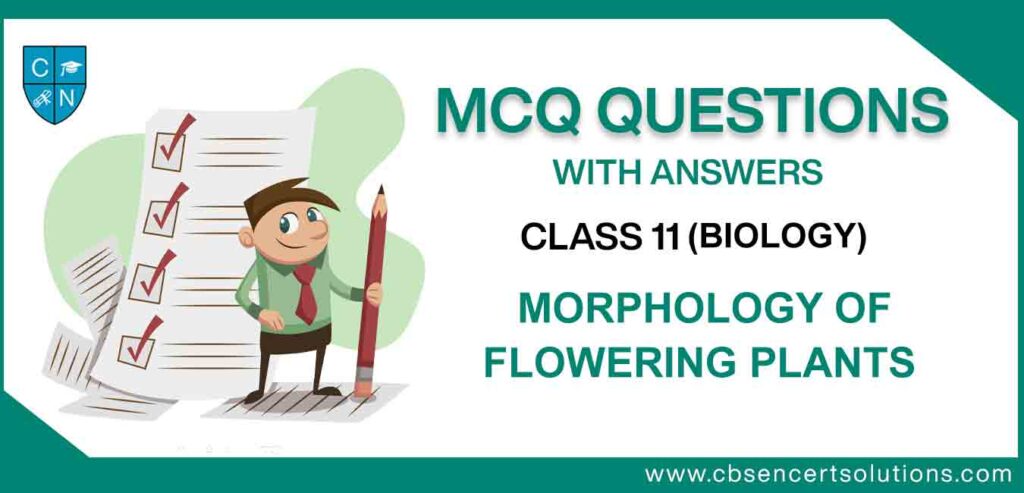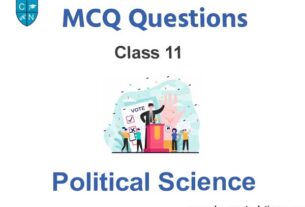Students can refer to the following Morphology of Flowering Plants MCQ Questions for Class 11 with Answers provided below based on the latest curriculum and examination pattern issued by CBSE and NCERT. Our teachers have provided here collection of multiple choice questions for Chapter 1 Morphology of Flowering Plants Class 11 Biology covering all topics in your textbook so that students can assess themselves on all important topics and thoroughly prepare for their exams
Morphology of Flowering Plants MCQ Questions for Class 11 Biology with Answers
We have provided below Morphology of Flowering Plants MCQ Questions for Class 11 with answers which will help the students to go through the entire syllabus and practice multiple choice questions provided here with solutions. As MCQ Questions for Class 11 Biology pdf download can be really scoring for students, you should go through all problems provided below so that you are able to get more marks in your exams.
Morphology of Flowering Plants MCQ Questions for Class 11
Question. In moss capsule, the number of peristome whorls are
(a) 1
(b) 2
(c) 3
(d) 4
Answer
B
Question. A mature ligule, having a prominent basal portion, is called
(a) glossopodium
(b) rhizophore
(c) trichome
(d) None of these
Answer
A
Question. Inflorescence of Ficus is
(a) spike
(b) hypanthodium
(c) raceme
(d) verticillaster
Answer
B
Question. Inflorescence is racemose in
(a) brinjal
(b) tulip
(c) Aloe
(d) soybean.
Answer
D
Question. In a cymose inflorescence the main axis
(a) has unlimited growth
(b) bears a solitary flower
(c) has unlimited growth but lateral branches end in flowers
(d) terminates in a flower.
Answer
D
Question. Cymose inflorescence is present in
(a) Solanum
(b) Sesbania
(c) Trifolium
(d) Brassica.
Answer
A
Question. The edible part of cauliflower is
(a) inflorescence
(b) leaf
(c) flower
(d) stem
Answer
A
Question. Most reduced form of stem is found in
(a) bulb
(b) rhizome
(c) tree
(d) stem
Answer
A
Question. In Opuntia, spines are modification of
(a) stem
(b) root
(c) leaf
(d) flower
Answer
C
Question. Free central placentation is found in
(a) Dianthus
(b) Argemone
(c) Brassica
(d) Citrus.
Answer
A
Question. The standard petal of a papilionaceous corolla is also called
(a) vexillum
(b) corona
(c) carina
(d) pappus.
Answer
A
Question. Among China rose, mustard, brinjal, potato, guava,cucumber, onion and tulip, how many plants have superior ovary?
(a) Three
(b) Four
(c) Five
(d) Six
Answer
D
Question. Clove is
(a) flower bud
(b) axillary bud
(c) thalamus
(d) ovule
Answer
A
Question. Pollinia are found in
(a) wheat
(b) madar
(c) mango
(d) banana
Answer
B
Question. Monocarpic plants flower
(a) once
(b) twice
(c) many times
(d) never
Answer
A
Question. Nodules with nitrogen fixing bacteria are found in
(a) cotton
(b) gram
(c) mustard
(d) wheat
Answer
B
Question. In which family (9) + 1 androecium condition is found ?
(a) Malvaceae
(b) Papilionaceae
(c) Solanaceae
(d) Poaceae
Answer
B
Question. Which of following type of anther is found in Malvaceae?
(a) Monothecous
(b) Dithecous
(c) Polythecous
(d) Without thecous
Answer
A
Question. Potato and sweet potato
(a) have edible parts which are homologous organs.
(b) have edible parts which are analogous organs.
(c) have been introduced in India from the same place.
(d) are two species of the same genus.
Answer
B
Question. The sugarcane plant has
(a) dumb-bell shaped guard cells
(b) pentamerous flowers
(c) reticulate venation
(d) capsular fruits
Answer
A
Question. The family containing mustard and its main characters are
(a) Brassicaceae – Tetramerous flowers, six stamens, bicarpellary gynoecium, siliqua type fruit
(b) Brassicaceae – Pentamerous flowers, many stamens, pentacarpellary gynoecium, capsule type fruit
(c) Solanaceae – Pentamerous flowers, five stamens, bicarpellary gynoecium, berry type fruit
(d) Poaceae – Trimerous flowers, three stamens, monocarpellary gynoecium, caryopsis type of fruit
Answer
A
Question. Velamen present in orchids help in
(a) absorbing water from support
(b) respiration
(c) absorption of moisture from air
(d) synthesizing food
Answer
C
Question. Composite fruit develops from
(a) single ovary
(b) inflorescence
(c) apocarpous ovary
(d) pericarp
Answer
B
Question. If the anthers are fused together forming a tubular structure while the filaments remain free, the condition is found in which one of the following family?
(a) Malvaceae
(b) Cucurbitaceae
(c) Solanaceae
(d) Asteraceae
Answer
D
Question. Floral diagram fails to indicate
(a) epiphylly and epipetaly
(b) aestivation and placentation
(c) position of ovary on the thalamus
(d) cohesion of carpels and stamens
Answer
C
Question. Aggregate fruit develops from
(a) syncarpous ovary
(b) multicarpellary, syncarpous ovary
(c) unilocular ovary
(d) multicarpellary, apocarpous ovary
Answer
D
Question. The presence of cilia, an oral groove, and food vacuoles, and the absence of chloroplasts in a unicellular organism indicate that the organism carries on
(a) sexual reproduction
(b) autotrophic nutrition
(c) extracellular digestion
(d) heterotrophic nutrition
Answer
D
Question. Of the following, which instrument is most commonly used to observe the external features of a grasshopper’s abdomen?
(a) Ultracentrifuge
(b) Microdissection instrument
(c) Dissecting microscope
(d) Electron microscope
Answer
C
Question. In a bisexual flower, if androecium and gynoecium mature at different times, the phenomenon is known as a
(a) dichogamy
(b) herkogamy
(c) heterogamy
(d) monogamy
Answer
A
Question. Which of following type of anther is found in Malvaceae?
(a) Monothecous
(b) Dithecous
(c) Polythecous
(d) Without thecous
Answer
A
Question. Parachute type dispersal occurs in
(a) tomato
(b) mustard
(c) pea
(d) cotton
Answer
B
Question. Prickles of rose are
(a) Modified leaves
(b) Modified stipules
(c) Exogenous in origin
(d) Endogenous in origin
Answer
C
Question. Which of the following are not characteristic features of fabaceae?
(a) Tap root system, compound leaves and raceme inflorescence.
(b) Flowers actinomorphic, twisted aestivation and gamopetalous.
(c) Stamens 10, introrse, basifixed, dithecous.
(d) Monocarpellary, ovary superior and bent stigma.
Answer
B
Question. Which one of the following is correctly matched?
(a) Onion – Bulb
(b) Ginger – Sucker
(c) Chlamydomonas – Conidia
(d) Yeast – Zoospores
Answer
A
Question. Read the following statements.
(i) Gynoecium is situated in the centre and other parts of the flower are located on the rim of the thalamus almost at the same level.
(ii) Ovary is half-inferior.
(iii) Examples are plum, rose and peach.
Answer
B
Question. Which condition of flowers is being described by the above statements ?
(a) Hypogyny
(b) Perigyny
(c) Epigyny
(d) None of these
Answer
D
Question. Seeds are adaptively important because
1. they maintain dormancy
2. they protect young plants during vulnerable stages
3. they store food for young plants, and facilitate dispersal
(a) 1 and 3
(b) 2 and 3
(c) 1 and 2
(d) All of these
Answer
D
Question. Which of the following is a modified stem for the protection of plants from browsing animals?
(a) Tendrils
(b) Thorns
(c) Rhizome
(d) Tuber
Answer
B
Question. Leaves of dicotyledonous plants possess _________ venation, while _________ venation is the characteristic of most monocotyledons.
(a) reticulate and parallel
(b) parallel and reticulate
(c) reticulate and perpendicular
(d) obliquely and parallel
Answer
A
Question. Placentation in which ovules develop on the inner wall of the ovary or in peripheral part, is D
(a) free central
(b) basal
(c) axile
(d) parietal.
Answer
D

Our teachers have developed really good Multiple Choice Questions covering all important topics in each chapter which are expected to come in upcoming tests and exams, as MCQs are coming in all exams now therefore practice them carefully to get full understanding of topics and get good marks. Download the latest questions with multiple choice answers for Class 11 Morphology of Flowering Plants in pdf or read online for free.
The above NCERT based MCQs for Class 11 Morphology of Flowering Plants have been designed by our teachers in such a way that it will help you a lot to gain an understanding of each topic. These CBSE NCERT Class 11 Morphology of Flowering Plants Multiple Choice Questions have been developed and are available free for benefit of Class 11 students.
Advantages of Morphology of Flowering Plants MCQ Questions for Class 11 Biology with Answers
a) Morphology of Flowering Plants MCQ Questions for Class 11 will help the kids to strengthen concepts and improve marks in tests and exams.
b) Multiple Choice Questions for Morphology of Flowering Plants Class 11 have proven to further enhance the understanding and question solving skills.
c) Regular reading topic wise questions with choices will for sure develop very good hold over each chapter which will help in exam preparations.
d) It will be easy to revise all Morphology of Flowering Plants chapters and faster revisions prior to class tests and exams.
Free Printable MCQs in PDF of CBSE Class 11 Morphology of Flowering Plants are designed by our school teachers and provide best study material as per CBSE NCERT standards.
You can easily get MCQs for Morphology of Flowering Plants from https://cbsencertsolutions.com
The MCQs for Class 11 Morphology of Flowering Plants with Answers have been developed based on current NCERT textbook issued by CBSE.
MCQs cover the topics of all chapters given in NCERT Book for Class 11 Morphology of Flowering Plants.
Yes – These Multiple Choice Questions for Class 11 Morphology of Flowering Plants with Answers are free to print and use them later.
No – All MCQs for Morphology of Flowering Plants are free to read for all students.
Just scroll and read the free MCQs.
Yes – you can download free MCQs in PDF for Morphology of Flowering Plants in standard MCQs format with Answers.
